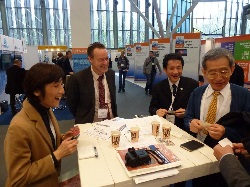IAC News
IAC News No.15, December 2013
Japan Society of Civil Engineers International Activities Center December 20, 2013 IAC News No.15
Civil Engineering in Japan and the World
Japan Society of Civil Engineers (JSCE) is responsible to the enhancement of civil engineering in broad terms covering almost all the matters whether they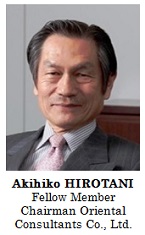 are built or natural, in Japan and the World. It is also taking care of transfer of superior Japanese civil engineering technologies to other parts of the world. Japanese civil engineers have been strongly proud of their technical superiority and have been very active all over the world. In recent years, however, those technologies especially ordinary kinds were already transferred and became very common in those countries which had once been a very lucrative market for the Japanese construction industry. Anything which becomes commodity is a target of price competition in the world market. Facing this situation, Japanese civil engineers are having a very stiff battle against competitors coming from those countries which were once defined as developing or newly emerging.
are built or natural, in Japan and the World. It is also taking care of transfer of superior Japanese civil engineering technologies to other parts of the world. Japanese civil engineers have been strongly proud of their technical superiority and have been very active all over the world. In recent years, however, those technologies especially ordinary kinds were already transferred and became very common in those countries which had once been a very lucrative market for the Japanese construction industry. Anything which becomes commodity is a target of price competition in the world market. Facing this situation, Japanese civil engineers are having a very stiff battle against competitors coming from those countries which were once defined as developing or newly emerging.
As a general rule, to maintain international competitiveness, there is no other way than to improve their engineering skills. In other words, we have to continue gaining our technical advantage over competitors such as developing and newly emerging countries by developing and broadening engineering itself. As an example, rather than ordinary design-construct-management for new construction, technology for shortening construction term, quality improvement, collaboration among firms and utilizing private firms management skills. Every conceivable means will be required. In addition to those above, the past experiences where Japanese industry had come through could be a strong point. Our country has experienced many periods such as recovery from destruction by war, high economic development and bubble burst. Through these periods, the industry has developed technology for providing facilities in massive amount, in larger unit, in composite form, in automation, and various kinds of new technologies, materials, combinations, machineries, ICTs and others. Furthermore, environmental issues along with high economic development have been dealt with very successfully. Advanced technologies for facility utilization, management, maintenance, and rehabilitation have been established.
On top of all those, we shall not forget about the fact that Japanese have tremendous superiorities which cannot be imitated by other countries. Those are highlighted at the presentation for inviting Tokyo Olympics as “O-Mo-Te-Na-Shi”, “sensitivity”, “courteous and serene society”, “comfortable security”, and “punctuality of services”. The same is also mentioned by foreign visitors and is the base of high esteem of Japan. It would be the strongest and unbeatable point to market in international competition.
JSCE – VFCEA – NUCE symposium to celebrate the 40th anniversary of Vietnam – Japan relation
Japan Society of Civil Engineers (JSCE), Vietnam Federation of Civil Engineering Associations (VFCEA) and National University of Civil Engineering (NUCE)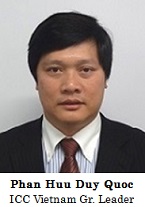 have just successfully organized a symposium on construction of underground structure, transportation and geotechnical engineering.
have just successfully organized a symposium on construction of underground structure, transportation and geotechnical engineering.
This year, Japan and Vietnam celebrate the 40th anniversary of the establishment of diplomatic relationship between Vietnam and Japan (1973 – 2013). Various celebrating activities have been organized and this symposium is one of recognized official events.
From the beginning of this year, Vietnam Group of International Activities Center had been working on the preparation works in cooperation with counterparts from VFCEA and NUCE. The local organizing committee in Vietnam was led by the energetic Prof. Nguyen Truong Tien, who is head of VFCEA international activities, also the president of Vietnam Society of Soil and Geotechnical Engineering.
The main purposes were to create a chance for civil engineers to exchange information on common issues, build up the professional network, and to re-confirm the long-last friendship between the two nations.
Approximately three hundred people, including about 60 Japanese, participated in the two-day symposium held at Hochiminh Museum in the center of Hanoi capital.
The JSCE Delegation was led by the immediate past president of JSCE, Dr. Takehiko Ono, who has been working hard on promoting the Vietnam – Japan relationship in the field of Civil Engineering during his JSCE presidential term ended in June.
Four invited speakers from JSCE delivered 4 keynote presentations on Development of Metro Network (Prof. Morichi, National Graduate Institute for Policy Studies), Utilization of Underground Space (Prof. Matsushita, Shibaura Institute of Technologies), Shield Technologies for Urban Infrastructures (Mr. Kanemaru, Shimizu Corporation) and Pipe Jacking method for technical infrastructure (Mr. Yasuda, Yasuda Engineering)
Keynote and technical presentation drew a very clear picture on current issues and achievements in geotechnical engineering, underground construction, transportation, etc. in Vietnam, with strong focus on the cooperation between Vietnam and Japan in construction sector.
On the first day, 8 keynote presentations were delivered and 10 technical presentations were made by Japanese and Vietnam experts.
On the second day, besides remaining technical presentations, a special section was held for discussion on cooperation between JSCE and VFCEA in the coming time.
Both sides agreed that the cooperation should yield specific outcomes that serve the actual needs of construction activities in Vietnam and Japan, and create more chances for direct communication between engineers and researchers. Therefore, it was agreed that both sides would work together to establish some working groups on specific topics, including construction and utilization of underground space, construction and monitoring of long-span bridge, deep foundation and soil improvement, engineer education and qualification, etc. It was also agreed that civil engineering former students in Japan should be gathered in a network and play the bridging role between Vietnam and Japan civil engineering societies.
The symposium was ended by a technical visit to the construction site of Nhat Tan Bridge, a Japanese ODA project and also a symbol for the cooperation between Japan and Vietnam in developing infrastructure in Vietnam.
This symposium was strongly supported by various governmental organizations, including Japan Ministry of Land, Infrastructure, Transport and Tourism, Vietnam Ministry of Construction (MOC), Japan International Cooperation Agency (JICA), and Japanese Embassy in Vietnam. University of Transportation and Communication (UTC) and Vietnam Society Youth Civil Engineers (VSYCE) were also very supportive.
JSCE and VFCEA had established the first cooperation agreement in 2000 and re-confirmed this long-time relationship by a new MOU in 2012. JSCE has also signed the cooperation MOUs with Vietnam Bridge and Road Association (VIBRA) and Vietnam Association of Structural Engineering and Construction Technologies (VASECT) in 2012.
Just one day before this joint symposium, JSCE and NUCE had signed cooperation MOU and opened a new hub called Center for promoting Vietnam – Japan Civil Engineers Collaboration. This center is expected to be collaborating and communicating space where engineers from both countries can find many technical references from Japan (especially documents published by JSCE), having group meeting and jointly organizing collaborative activities.
It can be said that the symposium is a confirmation of Vietnam and Japan relationship, especially in civil engineering. In other word, it has initiated a new stage and a firmer basement for cooperation between JSCE with professional societies in Vietnam.
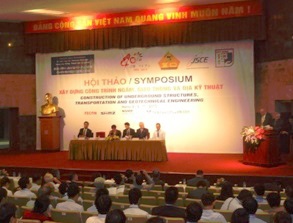 Opening section with more than 300 participants |
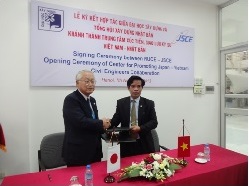 Exchanging MOU at the opening ceremony of collaboration center |
Report: PICE 39th National Convention
The Philippines Institute of Civil Engineers, Inc. (PICE) was held as its 39th National Convention in Davao City, Mindanao, Philippines on November 7 to 9, 2013. Dr. Yumio Ishii, the 95th JSCE President, and two other JSCE staff attended the convention as the JSCE delegation.
Mr. Momo, the PICE President declared the convention open, and delivered a presentation on Jakarta Protocol (Asian Civil Engineering Coordinating Council (ACECC) member societies signed in August, 2013) selected as the theme of the Convention. Mr. Momo emphasized the role of Civil Engineer in his opening remarks.
Plenary Session including PICE’s Report of 2013, the Conferment Ceremony, and Special Lectures was given in the afternoon. At Special Lectures, the establishment of PICE Research and Development Office, the efforts on Code of Ethics and other topics were introduced.
The International Roundtable Discussion was held on the 2nd day on the theme of ” International Cooperation Among Civil Engineers on Disaster Risk management.” Dr. Ishii provided topics on disaster response based on lessons learned from 2011 Great East Japan Earthquake. PICE introduced their effort of initiating EQRP (Earthquake Quick Response Program) which is a preparation for prompt responses to potential disasters.
JSCE was honored to have the opportunity of delivering a speech at Closing Ceremony on the final day. Dr. Ishii expressed his gratitude for the invitation and also for giving him the opportunity to make a presentation at the International Roundtable. Dr. Ishii informed about JSCE’s 100th anniversary events scheduled next year including the international meetings and Asian Board Meeting, and handed out an invitation from JSCE President Mr. Hashimoto to PICE President Mr. Momo for the JSCE 100th commemorative international conference.
Then, after the Technical Session and the ceremony of PICE National Chapter Awards presented by President Mr. Momo, the convention was closed.
During the days of the PICE’s National Convention, Typhoon Haiyan hit the central Philippines leaving thousands of victims. Fortunately, Davao City didn’t suffer much damage from it, and we could accomplish the mission safely. We JSCE have to develop the relationship with PICE so that we will be able to contribute to enhance disaster risk management all over Asia.
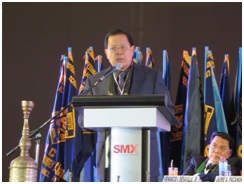 Mr. Romeo S. Momo PICE President |
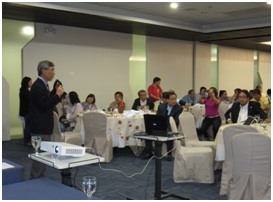 Dr. Yumio Ishii delivers a presentation at RTM |
IAC Current News (Kotaro Hashimoto The 101st JSCE President)
◆A Trip to UK and the Netherlands in Autumn
I took a flight to visit the UK and the Netherlands for the purpose of inviting our counterparts ICE and KIVI NIRIA to JSCE’s 100th Anniversary Celebration for a week from November 3 to 9.
My first visit was the Institution of Civil Engineers (ICE) in London with Prof. Makimasa Fujiwara IAC UK group leader, Dr. Takashi Wada of The Highways Agency, on 4. We had a good discussion with Prof. Barry Clark the ICE President and Mr. Nick Baveystock, Director General. Prof. Clark gave us a tour in the ICE Headquarters, including its library. The 200-years-old HQ, which was built in 1818, was enveloped in a gland and solemn atmosphere and described that civil engineers were was highly respected in the society. After the meeting, we joined Mr. Teruhiko Tsumura the secretary general of JSCE UK Section and a few section member, too. It was very nice to meet our members overseas.
Next day I flew to Amsterdam to attend International Water Week Conference Amsterdam (IWW) on 5 and 6. Among several sessions offered in the IWW, I attended risk management in Delta Project, mitigation measures to minimize the impact of storm water discharge on urban waters and others. I also walked around the exhibition areas where over 880 organizations and agencies showed their latest innovations and products at their booths, and among them found only 5 booths set up by Japanese companies.
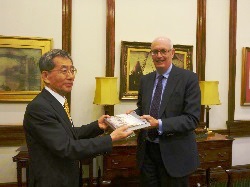 Prof. Clark gives a book to Mr. Hashimoto as a welcome gift |
|
In the meantime, I had an appointment with Mr. Bob Oeloff of Ministry of Infrastructure and the Environment, Mr. Martien Beek of Delta Programme Commissioner and Mr. Tom Kompier of Ministry of Foreign Affairs. We discussed water risk management, practices, and policies in two countries. It was a very informative and useful meeting. We promised to meet again with each other again.
Then, leaving after the exhibition area, I got together with Prof. Hiroaki Furumai of the University of Tokyo a session chair, Mr. Hiroki Itokawa of Japan Sewage Works Agency a session speaker and Prof. Franz van de Ven of Delft University of Technology. Prof. van de Ven was a speaker at the J. de Reijke Symposium which was held in Tokyo in July, hosted by the Embassy of the Netherlands. Everybody felt relaxed and enjoyed exchanging ideas with each other in over dinner in a relaxed atmosphere.
On the last day of my trip, I went to Den Haag to visit the Royal Institute of Engineers in the Netherlands (KIVI NIRIA). Prof. J.K. Vrijling, the chair of civil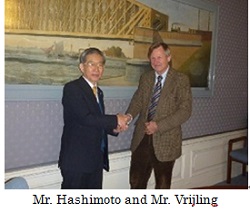 engineering committee, and Dr. Micaela dos Ramos, Director of KIVI NIRIA warmly welcomed me. They intently listened to me and willing to accept my invitation to the 100th Anniversary Celebration next year. I have to add that I made a detour to Hringvlietdam and Maestlantkenring the storm surge barrier as part of the Delta Works, located in South Holland on my way to the KIVI NIRIA.
engineering committee, and Dr. Micaela dos Ramos, Director of KIVI NIRIA warmly welcomed me. They intently listened to me and willing to accept my invitation to the 100th Anniversary Celebration next year. I have to add that I made a detour to Hringvlietdam and Maestlantkenring the storm surge barrier as part of the Delta Works, located in South Holland on my way to the KIVI NIRIA.
The schedule was packed with meetings and traveling from one place to another, but was meaningful and fruitful for me to meet several interesting people who showed keen interests in the 100th Anniversary Celebration, visit major projects and learned another t perspectives of civil engineering in those countries.
I am thankful to all the people who kindly welcomed and worked with me in this trip. Thank you very much.
What's Happening
Updates
●The summary of feature articles in the JSCE Magazine is available on the JSCE website.
http://www.jsce-int.org/pub/magazine
●Concrete Committee International Newsletter No. 35
http://www.jsce.or.jp/committee/concrete/e/newsletter/Newsletter.htm
IAC News Subscription
The IAC News is one of the communication tools to share information and ideas with the members. We would like to invite you, your friends and colleagues to join the communication and to subscribe the IAC News. Please register online: (http://committees.jsce.or.jp/s_iad/iac_news_e). We look forward to meeting you.
Registration form for IAC News subscription:
・Japanese :(http://committees.jsce.or.jp/kokusai/node/31)
・English :(http://www.jsce-int.org/pub/registration/non-international_students)
・English for those who have studied/ graduated from Japanese colleges and universities :
(http://committees.jsce.or.jp/kokusai/node/30)
Y's Murmuring
There is a simple, elegant bridge “Ippon-bashi Bridge” in Kyoto. It is a 70cm-wide stone bridge, spanning Shirakawa River, which was built in the 18th century. It is known as the very first bridge which be crossed by Sennichi Kaihogyo (Thousand Day Walk) practitioners of Mt. Hiei when they enter the Kyoto city. It is like a pencil laid over the river, yet fulfills its purpose nicely. The bridge, to me, symbolizes people’s desire and attempt to cross the river to the other side, and that is the very reason and purpose that civil engineers work for. I’m wondering if we need a bridge with frilly ornaments to cross a river. If you have chance to visit Kyoto, please make time to walk on the bridge.

